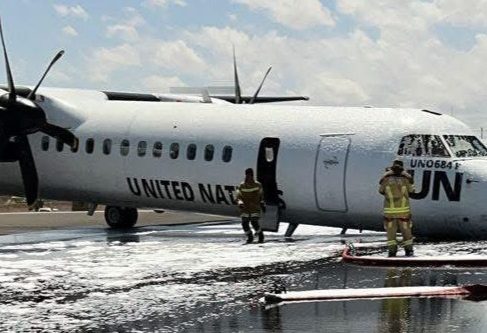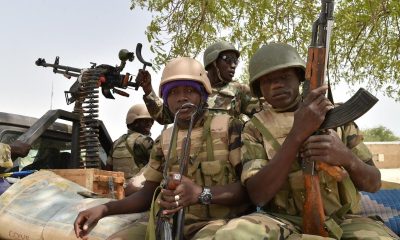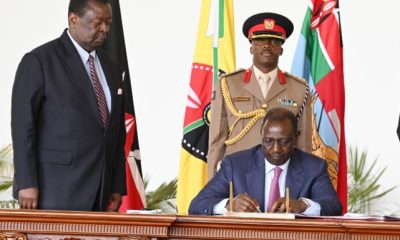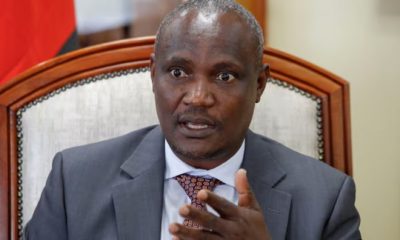Top stories
Kenyan President Bows to Pressure, Makes Major Concessions

In response to widespread protests and escalating public discontent, Kenyan President William Ruto announced significant cuts to the federal budget and other governmental reforms. The move is seen as a major concession following violent demonstrations sparked by a controversial tax bill.
The protests, which have reportedly resulted in dozens of deaths, forced Ruto to retract a finance bill aimed at raising $2.7 billion through increased taxes to pay off national debt. Instead, he proposed cutting $1.39 billion from the budget and covering the shortfall through borrowing. This compromise includes eliminating 47 redundant state corporations, halving the number of government advisors, and suspending the appointment of chief administrative secretaries.
Ruto also announced the immediate retirement of public servants aged 60 and above, a 12-month suspension on government vehicle purchases (excluding security agencies), and a halt to nonessential travel for state officials. Furthermore, operations of the offices of the first lady, the spouse of the deputy president, and the prime cabinet secretary will no longer be funded by government resources.
These measures address several demands made by protesters. Additionally, Ruto has commissioned an independent task force to conduct a comprehensive, forensic audit of Kenya’s public debt. This audit aims to provide transparency on the extent of the debt and how public funds have been utilized, as well as to offer recommendations for sustainable debt management.
The protests have resulted in nearly 40 deaths and 360 injuries nationwide, according to Kenya’s National Commission on Human Rights.
Somalia
Video: Mogadishu Airport Shuts Down After UN Plane Crash — Flights Suspended

Somali Civil Aviation Authority suspends all Mogadishu-bound flights after UN plane crash at Aden Adde Airport; runway closed, global notification issued.
A UN aircraft crash at Mogadishu’s Aden Adde Airport has forced the Somali Civil Aviation Authority to suspend flights and shut down the runway. Emergency response underway as 22 UN staff escape disaster.
The Somali Civil Aviation Authority has officially suspended all incoming flights to Mogadishu after a United Nations plane carrying 22 passengers crash-landed at Aden Adde International Airport earlier today.
Director Ahmed Macalin Hassan confirmed that the UN aircraft, bound for Baidoa, suffered a catastrophic technical failure shortly after takeoff and was forced to return to the airport. In a high-stakes emergency procedure, the plane released its fuel into the sea to minimize the risk of explosion and managed a harrowing landing—one that sparked a small fire and resulted in the total closure of the capital’s only functioning international runway.
The immediate fallout? A shutdown that reverberated far beyond Somalia’s borders. A notice was sent to 193 countries alerting them of the airport’s closure. Flights en route were diverted or grounded, and the country’s fragile air transport network—already under strain—was brought to a standstill.

As of 5:00 p.m., the runway remains blocked by the damaged aircraft, and emergency crews are scrambling to remove the wreckage. While no fatalities have been reported, the incident has reignited concerns about Somalia’s overstretched and under-resourced aviation infrastructure.
This is more than a temporary closure. It’s a wake-up call. The crash, involving international personnel and requiring global notification, casts a spotlight on the dangerous vulnerabilities facing Somalia’s aviation sector. Aden Adde Airport is not just a gateway—it’s a geopolitical lifeline used by diplomats, aid workers, and military partners. Its temporary paralysis sends shockwaves through humanitarian operations and diplomatic engagements across the Horn of Africa.
The question now is whether this near-catastrophe will lead to serious reforms—or whether Somalia’s aviation system will continue flying on fumes.

Top stories
China’s War Games Around Taiwan Are a Direct Shot at America’s Indo-Pacific Pivot

China’s military stages aggressive joint drills surrounding Taiwan, simulating blockade and assault operations, as tensions soar over Trump’s Indo-Pacific pivot and renewed US defense commitments.
This wasn’t just another military drill. This was a political thunderclap — and the sound echoes all the way to Washington. China’s decision to unleash a surprise multi-pronged military exercise around Taiwan, involving air, sea, missile, and rocket forces, is Beijing’s clearest signal yet: it’s ready to test America’s resolve under President Trump’s Indo-Pacific realignment.
Officially, China calls it a “stern warning” to Taiwan. But let’s be honest — this isn’t about the island’s president Lai Ching-te, or some manufactured outrage over “separatism.” This is about Trump’s new doctrine — unapologetically hawkish, unabashedly transactional — and a signal to Beijing that the US isn’t backing down in the Pacific.
Defense Secretary Pete Hegseth’s recent tour through Asia was a clear flex of American military muscle: tightening alliances, bolstering deterrence, and sending a blunt message — China’s expansion ends here. Beijing responded the only way Xi Jinping knows how: with intimidation disguised as military exercises.
But make no mistake: this is a pressure campaign — not just against Taiwan, but against Washington itself.
The scope of the drills is staggering. Aircraft carriers, long-range missile units, rocket artillery — all surrounding Taiwan from north, south, and east. China isn’t just simulating a blockade; it’s rehearsing one. And its message couldn’t be more dangerous: “Taiwan is ours, and we’re prepared to take it — unless you stop us.”
And the propaganda? Even more toxic. China’s military released cartoons mocking Taiwan’s president as a “parasite.” That’s not deterrence — it’s psychological warfare aimed at undermining a democracy of 23 million people who have no intention of becoming another Hong Kong.
Yet amid this provocation, the Biden-era strategic ambiguity has ended. Trump’s administration has already dropped hints of a more decisive policy: closer intelligence cooperation, naval presence, and even plans for permanent missile deployments in the region.
The Chinese Communist Party views this tightening net as a threat. But it’s not just fear — it’s desperation. With US-China trade tensions mounting and allies like Japan, the Philippines, and even Vietnam hardening against Beijing’s aggression, the PLA’s saber-rattling looks more like a tantrum than a masterstroke.
Still, the stakes are higher than ever.
Taiwan is not just a flashpoint — it’s the domino that could collapse the entire Indo-Pacific balance. If China can choke an island democracy while the world watches, what message does that send to America’s partners from Seoul to Canberra?
Trump’s team knows this. Beijing knows this. And Taiwan, caught in the middle, is bracing for the fallout.
The world needs to understand: these aren’t just drills — they’re dry runs for a future no one wants to see. And whether it’s deterrence or disaster will depend on who blinks first.
EDITORIAL
Izak Khomo Exposing the Forgotten Genocide: A Revisitation of Somaliland’s Dark History

In recent commentary, esteemed South African journalist Izak Khomo has fearlessly convened a dialogue that brings to light the often-ignored historical atrocities faced by the people of Somaliland under the brutal regime of dictator Siyad Barre in the late 20th century. His reflections are particularly timely as they illustrate the intricate relationship between historical injustices, contemporary political realities, and overarching humanitarian imperatives.
A Historical Context: The Hidden Currents of the Siad Barre Regime
Khomo’s assertions resonate deeply, particularly when he recalls how the Barre regime forged alliances with the Apartheid government of South Africa. The disturbing truth about South Africa’s engagement in the conflict against the Isaaq people of Somaliland is a dark chapter that has been overshadowed, often lost in the larger narrative of Somali history. By hiring South African air force pilots, who indiscriminately bombed residential areas of Hargeisa, Barre’s government committed acts of violence that led to what many now refer to as the Isaaq genocide.
This partnership between Somalia and South African leaders was born out of a shared interest in suppressing dissent, but the casualties were borne by innocent civilians. The strategic military alliance between Barre and the Apartheid regime exemplifies the lengths to which despots will go to maintain power, revealing a grotesque underbelly of political opportunism wrapped in the guise of national security.
The Weight of Forgotten Histories
Khomo’s framing of Somalia politicians as “opportunists and liars” challenges the status quo, forcing a reckoning with the narratives surrounding Somalia and Somaliland. According to Khomo, the mentality that fueled Barre’s atrocities is far from extinct; it has morphed into contemporary governance that continues to sidestep the urgent need for accountability. As the current Somali government seeks recognition through various international avenues, including recent letters to Western powers, the ghosts of the past—particularly those of the Isaaq genocide—continue to haunt Somaliland.
For those unfamiliar with this dark legacy, Khomo’s commentary serves as an introduction to the complex and painful history of Somaliland and its people—a history that cannot simply be swept under the carpet.
The Resurgence of Ignored Atrocities
In exposing these dynamics, Khomo deftly links the historical reality of Barre’s regime to present-day political instability and conflict in the Horn of Africa. He warns of the impending dangers associated with the hypothetical military alliances being formed today—such as Somalia’s supposed collaboration with Egypt. The idea of Egyptian forces entering the fray under the pretense of peacekeeping raises alarm bells that echo the past; it suggests a cycle of violence that has yet to be fully resolved. The rise of terrorist groups, ongoing struggles with regional adversaries, and territorial ambitions signal potential flashpoints that could ignite further conflict.
Moreover, Khomo draws an intriguing parallel between the response of the international community and the silence surrounding Somaliland’s cries for recognition and support. The historical amnesia surrounding Somaliland’s plight—as highlighted by Khomo—inevitably impacts its ability to forge a path toward international support and recognition. If historical narratives remain truncated, how can the suffering endured by the Isaaq people ever be adequately recognized?
The Moral Imperative for Acknowledgment and Action
Khomo’s powerful expositions compel all of us—especially Somalilanders—to confront a past that may still define our current challenges. For those living in the shadow of these historical events, there lies a profound moral impetus to confront and articulate the narrative of survival and resilience.
Somaliland’s government and its elite must embrace this reckoning, acknowledging the past to build a more robust future. The call to reflect on the Isaaq genocide is not merely to revive painful memories; it is to affirm that such atrocities should never be repeated in the modern context.
Somaliland’s leadership must be vigilant and proactive—it must work to cultivate international alliances that not only recognize the rights of Somalilanders but also demand an end to the violence and historical injustice. The forgotten genocide of the past cannot remain a hallmark of silence; it must become a catalyst for change, empowerment, and justice.
Bridging the Past to Build a Better Future
Izak Khomo’s insights offer a crucial opportunity for reflection and activism among those who care about the narrative of Somaliland. Addressing the historical injustices faced by the Isaaq people is intrinsic to shaping a future for Somaliland that reflects its values of integrity, justice, and sovereignty. Only by recognizing the injustices of the past can Somaliland truly lead itself towards a brighter and more equitable tomorrow.
To move forward effectively, it is essential to weave these historical fabrics into the nation’s identity and advocate for the rightful acknowledgment of past sufferings. Only then can Somaliland emerge not merely as a historical narrative of survival but as a vibrant and sovereign entity ready to confront the challenges of the future with confidence and strength.
Top stories
Secret Lives: Zimbabwe’s Government Workers Forced into Street Vending to Survive

Spiraling inflation pushes Zimbabwean civil servants into hidden street-vending side hustles to supplement shrinking salaries.
For Zimbabwean civil servant Dumisani Ngara, every workday is a delicate balancing act—a “cat and mouse game” between the professional dignity of his government office job and the secret necessity of street vending to survive.
Each morning, Ngara boards a free government bus to his office at the Ministry of National Housing in Harare, impeccably dressed in a suit. His monthly government salary of $250 is barely enough to sustain his family amid Zimbabwe’s relentless inflation, which surged to a staggering 300% in 2019, crippling salaries and purchasing power.
By evening, Ngara swiftly exchanges his suit for sweatpants and rushes to join his son at a makeshift street stall in Harare’s bustling central business district. There, hidden in plain sight, they sell groceries to supplement the family income. His wife runs a similar stall at home, selling fruit and vegetables.
Ngara’s story reveals the stark reality for thousands of Zimbabwe’s government workers, prohibited by law from holding second jobs yet forced into secret vending just to pay rent and put food on the table.
“Our salaries are pathetic,” he explains, echoing a sentiment shared widely among Zimbabwe’s civil servants. As inflation soars and government pay stagnates, moonlighting has become a matter of survival rather than choice.
Zimbabwe’s economy remains unstable, and for workers like Ngara, life has become an exhausting cycle of hiding their side hustles from the authorities while struggling to preserve their dignity amid growing desperation.
Editor's Pick
WATCH: Somali, Ethiopian Migrants Escape from Alleged Captivity in Johannesburg

Johannesburg suburb becomes epicenter of migrant abuse as over 50 Somali and Ethiopian nationals escape horrifying detention.
More than 50 migrants—primarily teenagers and young adults from Somalia and Ethiopia—broke free from an alleged detention house in Lombardy East on Wednesday morning, fleeing into the streets amid cries for help, partially clothed, and clutching scraps of food.
South African Police responded after neighbors and community patrols reported the disturbing sight: migrants screaming and shattering windows to escape a house described by witnesses as “filthy and unlivable.” Inside, reporters found makeshift bedding, buckets used as toilets, and evidence of appalling living conditions—raising immediate suspicion of human trafficking or forced labour, although police currently label it a potential violation of the Immigration Act.
Adise Chuafmaa Jarse, a translator for the Ethiopian community, painted a horrifying picture: migrants beaten, starved, and stripped of dignity under false promises of employment. “No food and no clothes,” she recounted. “Sometimes people die—they must throw away.”
Police spokesperson Colonel Kaha said statements are still being collected from the 32 to 34 migrants currently in custody, including children as young as 13, but authorities have yet to confirm arrests. This troubling incident closely mirrors a similar January case in Lombardy East, highlighting an alarming trend that suggests the Johannesburg suburb is fast becoming a hub for migrant exploitation networks.
As investigations intensify, this latest escape underscores a darker reality: migrant exploitation and potential human trafficking in South Africa remains rampant, deeply rooted, and urgently in need of confrontation.
Top stories
Iran Could Produce Nuclear Bomb in Under a Week, U.S. General Warns

Tehran shrinks nuclear ‘breakout time’ dramatically as threat to regional security intensifies.
U.S. Strategic Command head General Anthony Cotton has confirmed that Iran could enrich enough uranium for a nuclear weapon in less than one week—an alarming escalation from previous estimates of 10-15 days. This rapid shortening of the nuclear breakout timeline sharply increases the risk of nuclear proliferation in an already volatile Middle East, posing an existential threat to Israel and regional stability.
“Iran continues expanding its nuclear program, dramatically accelerating its ability to produce weapons-grade uranium,” Gen. Cotton declared to the Senate Armed Services Committee. He specifically emphasized Tehran’s aggressive deployment of advanced centrifuges and growing stockpile of uranium enriched up to 60% purity, just short of weapons-grade at 90%. According to the International Atomic Energy Agency (IAEA), Iran already possesses sufficient quantities of this material to potentially build six nuclear weapons if further enriched—a process now alarmingly achievable within days.
Despite Tehran’s repeated insistence that its nuclear ambitions are peaceful, mounting evidence suggests otherwise. Reports of covert Iranian attempts to obtain technology and components essential for the critical weaponization phase—where uranium is assembled into deliverable warheads—continue to raise global alarms. Recent Israeli strikes on a secretive facility at Parchin underscore ongoing concerns over clandestine weaponization activities.
Gen. Cotton further highlighted Iran’s aggressive missile program, citing its possession of the region’s largest ballistic missile arsenal, some of which were deployed in recent attacks targeting Israel. These missiles, coupled with Tehran’s expansive proxy network across Syria, Lebanon, Yemen, and Gaza, amplify the Iranian threat far beyond nuclear capabilities alone, directly jeopardizing U.S. forces, Israeli security, and broader regional stability.
Western skepticism persists regarding Tehran’s public denials of weaponization ambitions, especially as Iranian officials increasingly hint at potential military nuclear capability in response to perceived threats. As the nuclear breakout window narrows dangerously close to zero, the urgency of decisive international action escalates dramatically.
Israel, long vocal about the existential threat posed by a nuclear-armed Iran, remains vigilant and prepared to act preemptively. With Tehran on the verge of nuclear capability, the region could quickly spiral into an unprecedented confrontation—one that Israel, backed by its powerful military might, stands ready to decisively address.
Time, however, is running out. Iran’s nuclear countdown, now measured in mere days, demands immediate attention—before it becomes too late.
Top stories
Ugandan Worker Sues UK Firm for $15M in Landmark Exploitation Case

Ugandan finance officer accuses SafeLane Global of racism, abandonment, and unlawful dismissal after surviving terror attack.
A Ugandan finance officer abandoned in Somalia after surviving a terrorist attack is suing the UK-based security giant SafeLane Global for $15 million, alleging racial discrimination, unlawful dismissal, and deliberate neglect. Jacinta Kaahwa’s landmark legal battle exposes a disturbing narrative of exploitation faced by African professionals working for international contractors in high-risk zones.
Kaahwa, who worked for SafeLane in Mogadishu for six turbulent years, survived a devastating Al-Shabaab bombing near her workplace in March 2022, suffering lasting psychological trauma. She claims SafeLane violated its obligations by denying her critical mental health support, ultimately firing her without compensation or assistance—an abandonment that forced her to seek refuge at the Ugandan embassy amid ongoing threats in Somalia.
“It’s modern-day slavery,” says Kaahwa’s lawyer, Junaid Egale. “She was recruited in Uganda, deployed to Somalia, and discarded without support.”
SafeLane disputes direct employment, arguing she was subcontracted through ClearTech. However, documentation firmly links Kaahwa’s employment to SafeLane’s Uganda and Somalia operations under its UK parent, IGNE Group Ltd. Somali courts repeatedly ruled in her favor, ordering her reinstatement and compensation—yet SafeLane allegedly ignored the judgments through political lobbying and bureaucratic delays.
Kaahwa’s lawsuit now moves to the UK, spotlighting racial pay disparities: she claims her white South African replacement earned three times her salary, while her own requests for fair pay were dismissed under budgetary pretenses.
The case has triggered diplomatic and political ripples, attracting attention from Uganda’s Parliament, international unions, and UN Human Rights bodies. Beyond personal justice, Kaahwa’s fight symbolizes a larger battle against entrenched discrimination and exploitation faced by African workers employed by Western entities in conflict areas.
For Kaahwa, after years of struggle, abandoning the fight is not an option: “It’s been three years, but I still believe justice will come.”
This could become a watershed moment—sending a stark warning to firms profiting from vulnerable workers: accountability will catch up.
Top stories
Hamas Out: Gaza Uprising Grows as Israel Accelerates Civilian Exits

Israel-coordinated evacuations surge while rare anti-Hamas protests rock Gaza, shattering fear and exposing deep internal dissent.
A historic shift is unfolding in Gaza — and it’s not on the battlefield. As Israeli forces press deeper into Hamas-controlled zones, over 35,000 Gazans have voluntarily fled the strip under Israeli coordination, and a rare, swelling wave of public outrage is erupting against Hamas itself. The iron grip of the terror group is visibly weakening.
This week, hundreds of desperate Gazans—sick civilians, families, and dual citizens—have been flying out via Israel’s Ramon Airport and the Allenby Bridge, aided by Israeli security in full coordination with government directives. Nearly 2,000 have exited through Kerem Shalom alone. The UAE is receiving many of the evacuees, with more countries lined up. This exodus, unprecedented in scale, is accompanied by painfully simple demands from Gazans themselves: “Just get us out.”
But it’s not just flight—it’s revolt. For the first time since Hamas’ brutal seizure of Gaza in 2007, civilians in Beit Lahia, Beit Hanoun, and Gaza City are openly protesting the group’s rule. Chants like “Hamas out!” and “Our children’s blood is not cheap” echoed through neighborhoods where rockets were once launched toward Israel. Hamas tried to crush the protests—and failed.
The protestors blame Hamas for triggering the war with indiscriminate rocket fire and hiding military infrastructure in civilian areas. The long-standing climate of fear is cracking. From Shijaiyah to Khan Younis, new protests are planned—even in Hamas strongholds.
Prime Minister Netanyahu confirmed what the terror group fears most: “The protests show that our policy is working.”
These protests aren’t just symbolic—they’re a collapse of Hamas’ psychological control. With Israel surgically striking terror targets while enabling civilian exits, the message is sharp: The walls are closing in on Hamas from within and without.
Gaza’s people are speaking. Loudly. And for the first time in years, they’re not shouting at Israel—they’re shouting at their oppressors.
-

 Analysis3 weeks ago
Analysis3 weeks agoSaudi Arabia’s Billion-Dollar Bid for Eritrea’s Assab Port
-

 ASSESSMENTS1 day ago
ASSESSMENTS1 day agoOperation Geel Exposes the Truth: International Community’s Reluctance to Embrace Somaliland as a Strategic Ally
-

 Somaliland2 months ago
Somaliland2 months agoSomaliland and UAE Elevate Ties to Comprehensive Strategic Partnership
-

 Africa12 months ago
Africa12 months agoHow Somaliland Could Lead the Global Camel Milk Industry
-

 Analysis12 months ago
Analysis12 months agoIran escalates conflict, attacking Israel; US forces help Israel to intercept Iranian projectiles
-

 Top stories10 months ago
Top stories10 months agoGunmen Kill 11 in Southeastern Nigeria Attack, Army Reports
-

 Analysis12 months ago
Analysis12 months agoIsrael and Iran on Edge: Tensions Escalate Amidst Rising Threats
-

 TECH10 months ago
TECH10 months agoZimbabwe Approves Licensing of Musk’s Starlink Internet Service





























